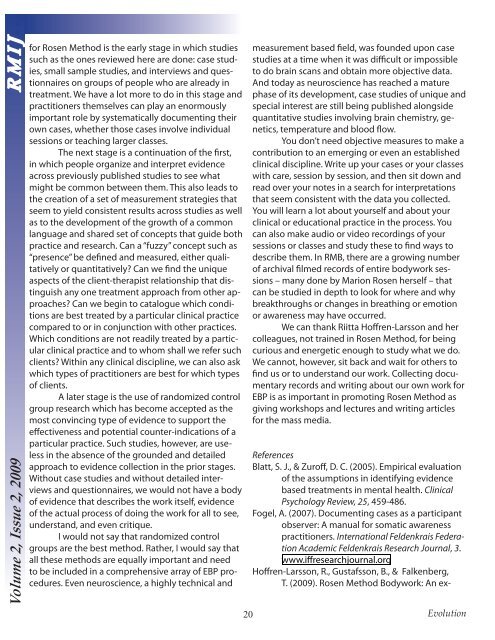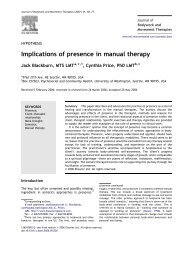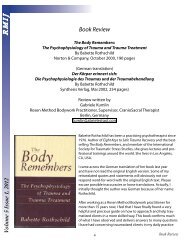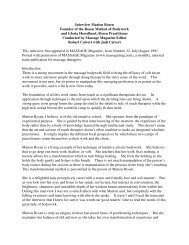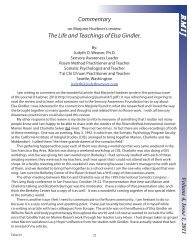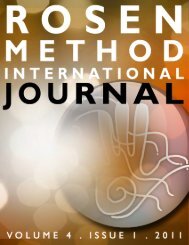RMIJ ... - Rosen Journal
RMIJ ... - Rosen Journal
RMIJ ... - Rosen Journal
Create successful ePaper yourself
Turn your PDF publications into a flip-book with our unique Google optimized e-Paper software.
<strong>RMIJ</strong>...<br />
Volume 2, Issue 2, 2009<br />
for <strong>Rosen</strong> Method is the early stage in which studies<br />
such as the ones reviewed here are done: case studies,<br />
small sample studies, and interviews and questionnaires<br />
on groups of people who are already in<br />
treatment. We have a lot more to do in this stage and<br />
practitioners themselves can play an enormously<br />
important role by systematically documenting their<br />
own cases, whether those cases involve individual<br />
sessions or teaching larger classes.<br />
The next stage is a continuation of the first,<br />
in which people organize and interpret evidence<br />
across previously published studies to see what<br />
might be common between them. This also leads to<br />
the creation of a set of measurement strategies that<br />
seem to yield consistent results across studies as well<br />
as to the development of the growth of a common<br />
language and shared set of concepts that guide both<br />
practice and research. Can a “fuzzy” concept such as<br />
“presence” be defined and measured, either qualitatively<br />
or quantitatively? Can we find the unique<br />
aspects of the client-therapist relationship that distinguish<br />
any one treatment approach from other approaches?<br />
Can we begin to catalogue which conditions<br />
are best treated by a particular clinical practice<br />
compared to or in conjunction with other practices.<br />
Which conditions are not readily treated by a particular<br />
clinical practice and to whom shall we refer such<br />
clients? Within any clinical discipline, we can also ask<br />
which types of practitioners are best for which types<br />
of clients.<br />
A later stage is the use of randomized control<br />
group research which has become accepted as the<br />
most convincing type of evidence to support the<br />
effectiveness and potential counter-indications of a<br />
particular practice. Such studies, however, are useless<br />
in the absence of the grounded and detailed<br />
approach to evidence collection in the prior stages.<br />
Without case studies and without detailed interviews<br />
and questionnaires, we would not have a body<br />
of evidence that describes the work itself, evidence<br />
of the actual process of doing the work for all to see,<br />
understand, and even critique.<br />
I would not say that randomized control<br />
groups are the best method. Rather, I would say that<br />
all these methods are equally important and need<br />
to be included in a comprehensive array of EBP procedures.<br />
Even neuroscience, a highly technical and<br />
measurement based field, was founded upon case<br />
studies at a time when it was difficult or impossible<br />
to do brain scans and obtain more objective data.<br />
And today as neuroscience has reached a mature<br />
phase of its development, case studies of unique and<br />
special interest are still being published alongside<br />
quantitative studies involving brain chemistry, genetics,<br />
temperature and blood flow.<br />
You don’t need objective measures to make a<br />
contribution to an emerging or even an established<br />
clinical discipline. Write up your cases or your classes<br />
with care, session by session, and then sit down and<br />
read over your notes in a search for interpretations<br />
that seem consistent with the data you collected.<br />
You will learn a lot about yourself and about your<br />
clinical or educational practice in the process. You<br />
can also make audio or video recordings of your<br />
sessions or classes and study these to find ways to<br />
describe them. In RMB, there are a growing number<br />
of archival filmed records of entire bodywork sessions<br />
– many done by Marion <strong>Rosen</strong> herself – that<br />
can be studied in depth to look for where and why<br />
breakthroughs or changes in breathing or emotion<br />
or awareness may have occurred.<br />
We can thank Riitta Hoffren-Larsson and her<br />
colleagues, not trained in <strong>Rosen</strong> Method, for being<br />
curious and energetic enough to study what we do.<br />
We cannot, however, sit back and wait for others to<br />
find us or to understand our work. Collecting documentary<br />
records and writing about our own work for<br />
EBP is as important in promoting <strong>Rosen</strong> Method as<br />
giving workshops and lectures and writing articles<br />
for the mass media.<br />
References<br />
Blatt, S. J., & Zuroff, D. C. (2005). Empirical evaluation<br />
of the assumptions in identifying evidence<br />
based treatments in mental health. Clinical<br />
Psychology Review, 25, 459-486.<br />
Fogel, A. (2007). Documenting cases as a participant<br />
observer: A manual for somatic awareness<br />
practitioners. International Feldenkrais Federation<br />
Academic Feldenkrais Research <strong>Journal</strong>, 3.<br />
www.iffresearchjournal.org<br />
Hoffren-Larsson, R., Gustafsson, B., & Falkenberg,<br />
T. (2009). <strong>Rosen</strong> Method Bodywork: An ex-<br />
20 Evolution


